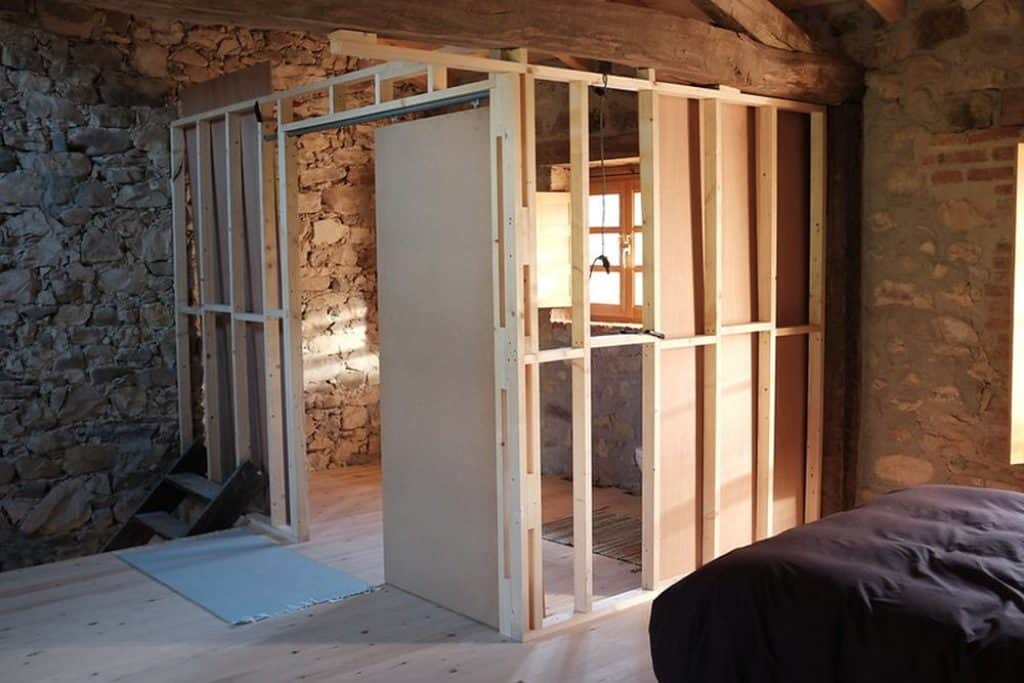Drywall Anchors vs Studs – Is There A Difference?
Drywall anchors are not a thing of the past now and have been essential for people who do DIY décor.
As drywalls of gypsum are quite common in house nowadays, drywall anchors are being used more often to hang things on the walls.
From lighter home décor objects to heavyweight objects, drywall anchors are a good tool for beginners to use.
But there is an alternative for these anchors in the market called the studs.
Studs are usually already located in the house and just need to be found to drill a screw into it.
In this article, I’ll explore the pros and cons of drywall anchors versus studs and determine which method is best for your specific hanging needs.
So, whether you’re a DIY enthusiast or just looking to hang something securely, read on to learn more about drywall anchors vs studs.
| Drywall Anchors | Studs | |
| Strength | Can support moderate weight (up to 20 pounds) when properly installed | Can support heavy weight (up to 100 pounds) and provide a secure anchor for heavy items |
| Installation | Easy to install with basic tools and no need for locating studs | Requires locating studs with a stud finder and may require more advanced tools for installation |
| Versatility | Can be used to hang a variety of items, including lightweight picture frames and small shelves | Best for heavier items, such as large mirrors or cabinets, that require a secure anchor |
| Wall Damage | May cause damage to drywall if not installed properly or if weight limit is exceeded | Does not cause damage to walls when installed properly |
| Cost | Generally inexpensive and available in a variety of sizes and styles | Free, as studs are part of the structural framework of a building |
Table of Contents
What Are Drywall Anchors?
Most of time when we place a fastener like screw or nail into a wall made of bricks or concrete, it does not hold tight and loses up easily.
To tightly hold these fasteners, a drywall anchor is necessary.
As the name suggests, a drywall anchor is just like a screw that is drilled into the surface to hold heavy objects.
Drywall is a sensitive material so it requires anchors to hold off large ad heavy objects.
This anchor allows to insert fasteners into the wall without causing the material to be damaged.
The drywall anchor must be inserted deep inside the wall to counterpart the weight of heavy objects being hung.
What Are Studs?

Studs are actually weightbearing supports that hold screws and bolts to increase supportability.
These studs can have larger board sizes to smaller sizes to support household items. Stud wood is usually 16 to 24 inches long.
A stud finder can be used to find studs to install a door or use a drywall anchor. Studs give a cleaner look to the project and requires heavy drilling machinery.
Drywall Anchors vs. Studs – What’s The Difference?
Choosing between drywall anchors and studs is a difficult choice as both have their advantages and disadvantages.
The difficult decision of drywall anchors vs. studs can be taken by understanding the major differences between them.
These differences are as follows:
Installation Process
Studs require some effort as one has to find the required stud and then drill the screw into it by using electronic tools.
Drywall anchors are easy to install around the house as they are directly drilled on the surface.
For beginner projects, drywall anchors are a must.
Weight Holding Ability
For heavier weights greater than fifty pounds, studs are a better option as they provide larger support.
While hanging heavy things on the wall, one must use studs with anchors for durability. Studs can hold weight in the range of 20-100 pounds.
On the other hand, drywall anchors come with optional weight of 15 to 20 pounds. These different ranges peak for greater supportability by studs.
Exterior Appearance
Studs usually give a cleaner and almost transparent appearance to the wall and gives a professional look.
On the other hand, drywall anchors can create a mess while drilling it into the wall, if not done properly.
Drywall anchors are a better option for beginners as they are easy to use. But studs are a cleaner option for professionals.
Drywall Anchors vs. Studs – Which One To Choose?
After knowing the difference between drywall anchors and studs, the next question arises as to what to choose?
This choice depends upon the situation and type of project.
If you need to hang a heavy object, then the best choice is to use studs as they provide great support.
You can find a stud and directly screw in it. But a stud is not available all the time, so you often need a drywall anchor anyway.
If the thing or project is lightweight, use easy to use drywall anchor.
But, if you are sure that the object is heavy, use studs for a greater support and professional exterior.
How Much Weight Can Studs Hold?
A screw in a stud can hold more than 100 pounds depending upon the grade of the screw.
Increasing the number of screws on a stud, can increase the weight holding ability of the stud.
If one screw holds 50 pounds, the doubling the screws will double up the weight capacity of stud, thus holding heavier objects.
Similarly, the distribution of load on the screws in a stud can affect the weight holding power.
How Much Weight Can Drywall Anchors Hold?
A drywall anchor can hold different ranges of weight depending on its types. Let’s have at a look at the types of anchors and their weight capacity.
Plastic Anchors
These drywall anchors are mainly used to fix screws into the wall. These are used for smaller projects and have the holding capacity of 15 pounds or less.
Self-Drilling Anchors
These anchors are like small crews but don’t need a hole to screw them into walls. They can hold weight up to 50 pounds.
Steel Hollow-Wall Anchors
These anchors have a metal jacket and provide greater support as steel helps to hold larger objects. These have the capability to hold weight less than 100 pounds.
Toggle Bolt Metal Anchors
These are best for concrete walls and are made of metal. With strongest support, they can easily hold greater than 300 pounds.
Doing the comparison of drywall anchors vs. studs, it can be essentially said that both have their own capacities and user can choose whatever based upon needs of project.
Can You Use Drywall Anchors Instead Of Studs?
The answer to this question is ambiguous and it all depend on the needs of the user.
If there is need of greater support, always use studs. But if the object is lighter and needs less support, drywall anchors are recommended.
For professional projects, studs cannot be replaced with drywall anchors.
But if beginners are trying to support their décor or objects on the wall, then a simpler option is drywall anchor.
How To Use Drywall Anchors And Studs?
Before using a drywall anchor, one must know the process of installing it. The first step is to mark the point where you want to hang your object.
Drill a hole deep enough to support an anchor at that point. Take the drywall anchor and press it deep until the head of anchor is inside the wall.
Afterwards insert the screw by using a screwdriver or manually. Don’t apply too much pressure. Once it is set, hang anything you want to.
For studs, one must find the studs by simply knocking at the wood or suing a mobile device or machine.
After locating stud, mark the point and rill a nail or screw into the wood stud for support.
Disadvantages Of Using Drywall Anchors And Studs
The biggest disadvantage of using drywall anchors is that there must be a hole drilled into the wall.
However, drywalls are fragile and cannot undergo heavy drilling.
This drilling can damage the wall as well. Small holes become visible on the wall which can cause a bad look to the wall and the whole project afterwards.
This creates a mess and is not suitable for sensitive surfaces. The best choice to make in this case is use of sotted anchors for lesser damage.
Studs have the disadvantage of installation process. Studs must be installed by drilling screws by using heavy drilling machines.
Also, it is not always possible to find a stud without a stud finder machine.
In some cases, many studs are required to supports drywall anchors due to heavy weights.
The increasing expense can make drywall anchors a better decision for consumers. But experts’ advice use of studs in a project.
Conclusion
Finally, after examining all the characteristics of drywall anchors and studs, it can be concluded that everything comes in the hand of consumer at the end.
If someone is willing to go to all lengths and get the perfect look, the studs is the best for them.
But if a beginner just needs something for support of décor or lighter weights, then drywall anchors are not harmful.
Greater support comes with usage of both studs and drywall anchors simultaneously.
So, user must choose wisely when thinking about the project. The final decision is based on weight capacity and durability of usage.




